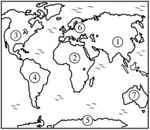
Worksheets and No Prep Teaching Resources
Reading Comprehension Worksheets
Earth Science

Earth Science
 Worksheets and No Prep Teaching Resources Reading Comprehension Worksheets Earth Science |
 Earth Science |
| edHelper's suggested reading level: | grades 9 to 10 | |
| Flesch-Kincaid grade level: | 9.33 |
|
Jigsaw Puzzle Earth
By Trista L. Pollard |

|
 1 Long before satellites and airplanes captured a view of our planet's surface, explorers were our only set of eyes. Through their travels they gave mapmakers information about oceans, new continents, and their coastlines. This is how our first reliable maps of Earth were made. Early explorers also noticed how the continental shorelines on both sides of the Atlantic Ocean appeared as if they fit together. They looked as if they were broken apart from a continental jigsaw puzzle. If you were to look at a world map, you may have noticed that the western coast of Africa appears to fit perfectly with the eastern coast of South America. Alfred Wegener also noticed this feature about our coastlines.
1 Long before satellites and airplanes captured a view of our planet's surface, explorers were our only set of eyes. Through their travels they gave mapmakers information about oceans, new continents, and their coastlines. This is how our first reliable maps of Earth were made. Early explorers also noticed how the continental shorelines on both sides of the Atlantic Ocean appeared as if they fit together. They looked as if they were broken apart from a continental jigsaw puzzle. If you were to look at a world map, you may have noticed that the western coast of Africa appears to fit perfectly with the eastern coast of South America. Alfred Wegener also noticed this feature about our coastlines. |
Create Weekly Reading Books
Prepare for an entire week at once! |
| Leave your feedback on Jigsaw Puzzle Earth (use this link if you found an error in the story) |
 |
Earth Science
|
 |
Continents Activities, Worksheets, Printables, and Lesson Plans
|
 |
High School Reading Comprehensions and High School Reading Lessons
|